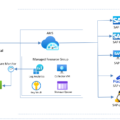A distributed denial of service (DDoS) attack is a type of cyber attack that overwhelms a target system with malicious traffic and requests in order to overwhelm its resources and prevent legitimate users from accessing it. In recent years, several large-scale DDoS attacks have made headlines, highlighting the potential damage these types of attacks can cause. Here we take a look at some of the most famous DDoS attacks over the past few years.
The first one on our list took place in October 2016, when the domain name service provider Dyn was hit with a 1.2Tbps DDoS attack. The attack caused major outages across many major websites including Twitter, Reddit, and Spotify. The perpetrators were never identified, but experts believe it was likely a botnet created using malware-infected IoT devices like cameras and routers.
Another notable DDoS attack happened in February 2018 when GitHub, one of the largest web hosting services for software development projects, was hit with a massive traffic surge. At its peak, 1.35Tbps of traffic was directed at the site which led to intermittent service outages for several hours before engineers managed to mitigate the attack.
In February 2020, Amazon Web Services (AWS) experienced one of the biggest DDoS attacks ever recorded which peaked at 2.3Tbps and lasted for about two hours before being neutralized by AWS’s security teams. The same month also saw another major DDoS attack that targeted Cloudflare’s infrastructure with an impressive 1.7Tbps peak traffic rate making it one of the largest volumetric attacks ever seen in 2020 so far.
Finally, there are two other historical events worth mentioning: The Mafiaboy Attacks of 2000 and The Largest DDoS Attack Ever Recorded in September 2017 which peaked at 2.5 Tbps directed at Google Cloud Armos customer services.. Despite years passing since these events occurred, they remain an important reminder that no system or website is immune to cyber threats if proper security measures are not taken into account by administrators and users alike.

The Most Notable DDoS Attacks
The most famous and largest distributed denial of service (DDoS) attacks are the September 2017 attack, the Mafiaboy attack which occurred in 2000, the Dyn attack which occurred in October 2016, the GitHub attack in February 2018, and the AWS attack in February 2020.
The September 2017 attack was an attempt to take down the popular hosting platform OVH. The attack involved over 1 terabit per second of malicious traffic directed at OVH’s servers.
The Mafiaboy attacks were a series of DDoS attacks targeting Yahoo!, eBay, CNN, Dell, and Amazon in early 2000. The attacks caused large amounts of downtime for these sites and were attributed to a single hacker using a botnet.
The Dyn attack was a DNS-based DDoS attack targeting DynDNS services in October 2016. This attack caused significant disruption to many popular websites across North America and Europe such as Twitter, Github, Reddit, PayPal, and Spotify.
The GitHub attack was a sophisticated DDoS campaign that targeted GitHub’s content delivery network (CDN) in February 2018. The attackers were able to send up to 1.35Tbps of traffic from different sources simultaneously, making it one of the largest recorded DDoS attacks at that time.
Finally, the AWS attack in February 2020 targeted Amazon Web Services (AWS). This massive DDoS campaign sent more than 2 terabytes per second of malicious traffic across different networks to take down its target services.
The Largest DDoS Attack on Google
The biggest Distributed Denial of Service (DDoS) attack ever recorded against Google took place in September 2017. The attack was a massive 2.5 Tbps onslaught, targeting the company’s services. If successful, it would have been the biggest DDoS attack ever recorded against any single organization and could have caused significant disruptions in service for users of Google products. Fortunately, Google was able to successfully defend against the attack and prevent any major disruptions from occurring. This incident highlights the importance of robust cybersecurity measures for organizations of all sizes, as cybercriminals become increasingly sophisticated in their tactics and technologies used for malicious attacks.
Can DDoS Attacks Lead to Jail Time?
Yes, using a booter or stresser service to conduct a DDoS attack can result in criminal prosecution and potential jail time. The Computer Fraud and Abuse Act (18 U.S.C. § 1030) makes such activities illegal, and violators can face fines and potentially up to 10 years in prison. Additionally, law enforcement may seize computers and other electronic devices used in the attack, as well as any profits that are gained from illegal activity.
Consequences of DDoS Attacks
If you are found guilty of using a DDoS attack to cause intentional harm to a computer or server, you could face a jail sentence of up to 10 years. A DDoS attack is when multiple computers are used to overwhelm the targeted computer or server with requests for data, thus preventing it from functioning properly. The severity of the sentence may vary depending on the level of damage caused by the attack and any other extenuating circumstances. It is important to note that in some countries, even if no damage was caused by the attack, they may still pursue charges and prosecute accordingly.
Does a DDoS Attack Last Indefinitely?
No, a DDoS attack does not last forever. They typically last from a few minutes to several hours, although in some cases they can persist for days or even weeks. However, the longer the attack lasts, the more costly and difficult it is to defend against. As such, most DDoS attacks are stopped within a few hours or less. To prevent future attacks, organizations should invest in solutions that specifically protect against DDoS and other types of cyberattacks.
Tracing the Source of a DDoS Attack
DDoS attacks are traceable, but the complexity and sophistication of the attack can make it difficult to identify who is behind it. In order to trace a DDoS attack, you must first understand the attack’s architecture. Most DDoS attacks involve the use of a botnet, which is a network of bots that carry out instructions from the attacker. To trace a DDoS attack, it is important to monitor and analyze network traffic to determine which IP addresses are associated with the botnet. Once these IP addresses are identified, investigators can then look for additional clues such as domain names or other identifying information associated with those accounts that may help lead them back to the attacker. Additionally, investigators can also use malware analysis techniques to study malicious code used by attackers in order to uncover more evidence about their identity. Ultimately, tracing a DDoS attack requires knowledge and skill – and often multiple tools – in order to properly identify who is behind it.
The Legal Consequences of DDoS Attacks
Yes, you can be sued for initiating a DDoS attack. DDoS attacks are illegal and may result in criminal charges as well as civil liability for damages. Depending on the severity of the attack and the extent of any damages caused, potential penalties may include fines, restitution, or even jail time. In addition to criminal charges, victims of a DDoS attack can also bring civil lawsuits against those responsible. Such lawsuits may seek compensation for lost business revenue, damage to reputation, or other losses resulting from the attack. Ultimately it is up to the court to determine whether damages are appropriate and how much should be awarded.
Real-Life Example of a DoS Attack
A real-life example of a denial of service (DoS) attack occurred in October 2016 when an attacker used an Internet of Things (IoT) botnet to launch a massive distributed denial of service (DDoS) attack against the domain name system (DNS) provider Dyn. This attack caused major websites, including Twitter, Reddit, Amazon, and Netflix, to be unavailable for several hours. The attacker was able to achieve this by sending massive amounts of data from hundreds of thousands of infected IoT devices to Dyn’s DNS servers at once, overwhelming them and preventing them from functioning properly. Ultimately, the attack highlighted the security risks posed by IoT devices and showed that even large companies with robust security measures in place can be vulnerable to such attacks.
Has Among Us Experienced a DDoS Attack?
Yes, Among Us experienced a Distributed Denial of Service (DDoS) attack over the weekend, which caused the game’s servers to be offline. A DDoS attack occurs when an attacker floods a target server with malicious traffic, overwhelming its system resources and causing it to become unavailable. As a result of this attack, players were unable to access Among Us throughout the weekend until the issue was resolved.
Are DOS Attacks Still in Use?
Yes, DOS attacks are still used today. A DOS (denial of service) attack is an attempt to make a computer or network resource unavailable to legitimate users. It does this by flooding the target with unwanted traffic, which can overload the system or cause it to crash.
DOS attacks have become more sophisticated over time and are now commonly used in conjunction with other malicious activities such as phishing and ransomware. Attackers may use a combination of techniques such as distributed denial of service (DDoS) attacks, botnets, and malware to overwhelm a targeted computer or website. DDoS attacks are particularly effective because they involve multiple compromised devices that send large amounts of data simultaneously, making it difficult for organizations to protect themselves against them.
Organizations need to be aware of the potential risks posed by DOS attacks and take steps to protect their networks accordingly. This can include setting up firewalls and other security measures, monitoring network activity for suspicious behavior, and using cloud-based services that can detect and block malicious traffic before it reaches the organization’s systems.
Understanding Layer 7 DDoS Attacks
A Layer 7 DDoS attack is a type of distributed denial of service (DDoS) attack that targets web applications. Specifically, it targets the Application Layer of the OSI model, which is responsible for providing services to application processes over the network. In this type of attack, malicious actors send a huge number of HTTP/S requests to a web server in order to overwhelm it with traffic. This floods the server resources and makes it difficult or impossible for legitimate visitors to access the content. As a result, websites can experience downtime, slow page loading times, and other performance problems. To protect against Layer 7 DDoS attacks, organizations can deploy Web Application Firewalls (WAFs) that detect and block malicious traffic before it reaches their servers.
Conclusion
In conclusion, distributed denial of service (DDoS) attacks have been a major issue for many online services. The most famous DDoS attacks include the AWS attack of February 2020, the GitHub attack of February 2018, the Dyn attack of October 2016, the Mafiaboy attacks of 2000, and the largest DDoS attack ever in September 2017. It is clear that DDoS attacks are a serious threat to online services and can cause widespread damage if successful. To defend against these threats, organizations must take proactive steps to secure their networks and resources.








